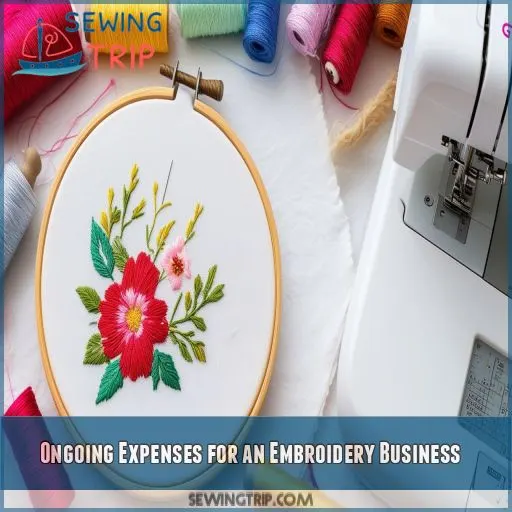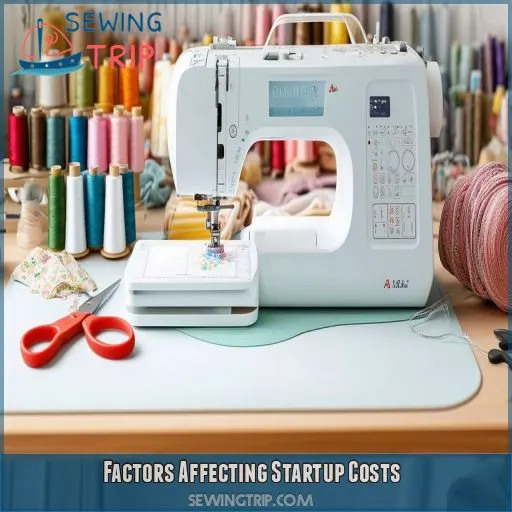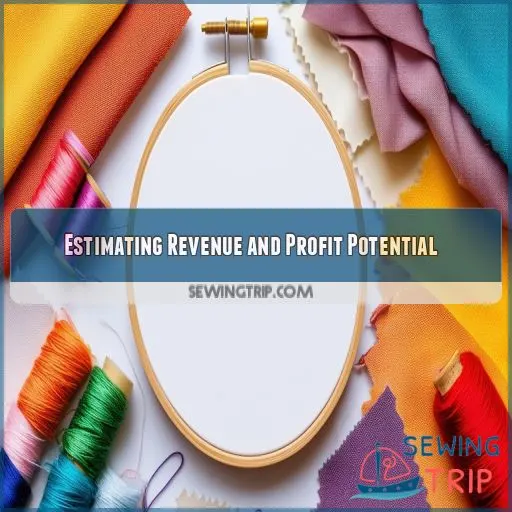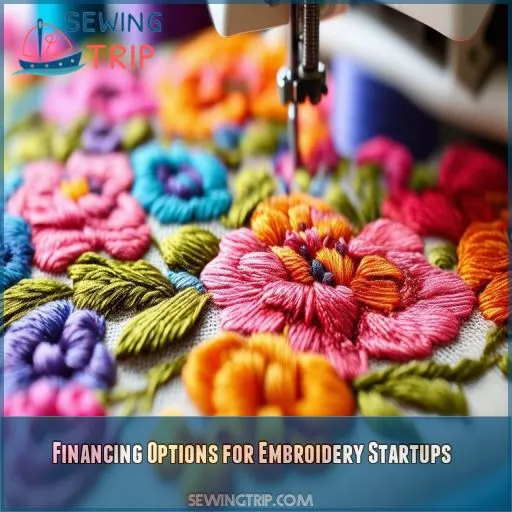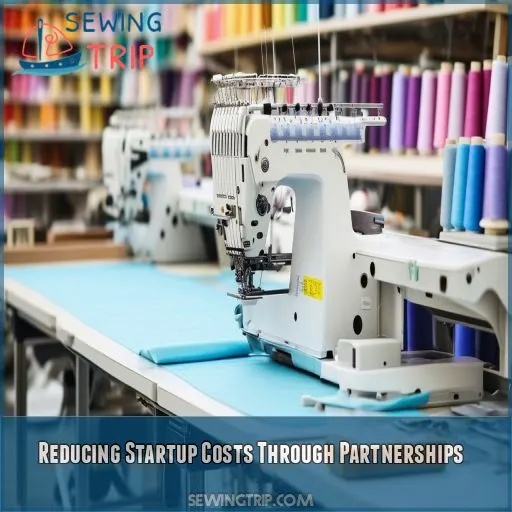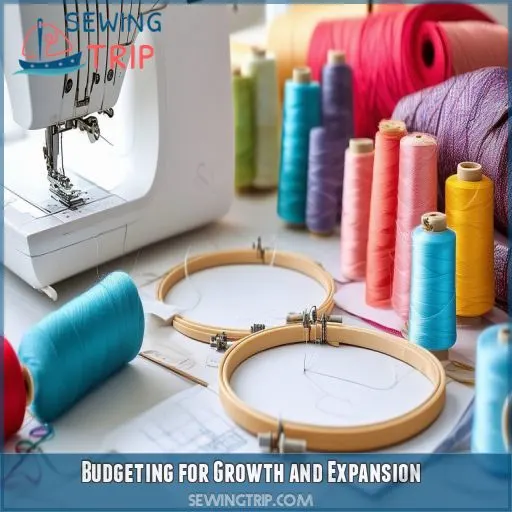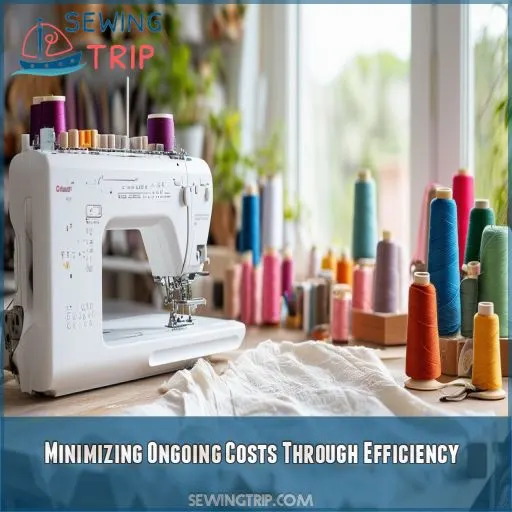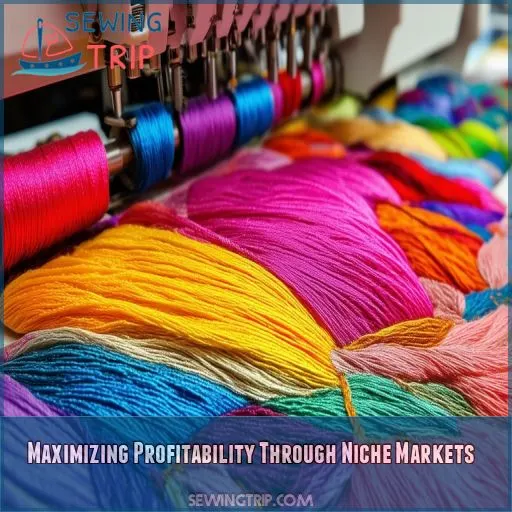This site is supported by our readers. We may earn a commission, at no cost to you, if you purchase through links.
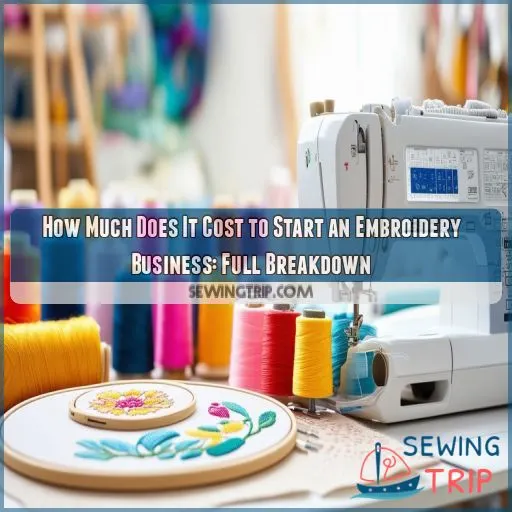
Ongoing expenses include rent, utilities, labor, and marketing. Your startup costs can vary depending on factors like whether you’re home-based or in a commercial space, and if you opt for new or used equipment.
To keep costs down, consider sharing equipment, outsourcing digitizing, or bartering services. With careful planning and smart choices, you can launch your embroidery business without breaking the bank.
Let’s stitch together a plan for your success!
Table Of Contents
- Key Takeaways
- How Much Does It Cost to Start an Embroidery Business?
- Startup Costs for an Embroidery Business
- Ongoing Expenses for an Embroidery Business
- Factors Affecting Startup Costs
- Estimating Revenue and Profit Potential
- Financing Options for Embroidery Startups
- Reducing Startup Costs Through Partnerships
- Budgeting for Growth and Expansion
- Minimizing Ongoing Costs Through Efficiency
- Maximizing Profitability Through Niche Markets
- Seeking Professional Advice for Financial Planning
- Frequently Asked Questions (FAQs)
- Conclusion
Key Takeaways
- Embark on your embroidery expedition with an investment ranging from a cozy $5,000 to a more substantial $20,000.
- Don’t let the thread of expenses unravel your plans! Plan meticulously for equipment, ongoing costs, and strategic investments to keep your business afloat.
- Maximize profitability like a master weaver! Explore niche markets, streamline operations, and forge partnerships to turn your embroidery dreams into golden threads.
- Remember, it’s all about the art of balance! Juggle efficiency and targeted niche markets to ensure your embroidery business flourishes like a vibrant tapestry.
How Much Does It Cost to Start an Embroidery Business?
The cost to start an embroidery business can range from $1,000 to over $25,000, depending on your equipment and setup needs (Source). Typical startup costs average around $11,000 for essentials like embroidery machines, software, and supplies .
Startup Costs for an Embroidery Business
To start an embroidery business, you’ll need a commercial single head machine, which costs under $12,000 and includes software, training, and supplies. Additionally, plan for inexpensive supplies like embroidery thread, backings, and needles to keep your operations cost-effective.
Equipment
When starting your embroidery business, invest in a multi-needle machine for efficiency. Choose an embroidery machine under $12K, which includes software, training, and initial embroidery supplies like threads and needles. Consider accessories, such as specialty hoops, and remember to budget for regular maintenance and any necessary digitizing services to keep your business running smoothly.
Software
When starting an embroidery business, you’ll need software to digitize designs and control your embroidery machine. Consider the following factors when choosing software:
- Design digitizing capabilities: Can the software convert images into embroidery files?
- Software compatibility: Is the software compatible with your embroidery machine and operating system?
- User interface: Is the software easy to use and navigate?
- Pricing options: What’re the costs of the software, and are there any subscription or maintenance fees?
- Software maintenance: What kind of support and updates does the software provider offer?
Supplies
You’ll need to stock up on essential supplies for your embroidery business, including embroidery thread, backing materials, and needles.
Invest in a good hooping system and specialty supplies like fabric, threads, and canvas.
Consider a supplies storage facility to keep your inventory organized.
With a home embroidery machine, you can start small and grow your supply stash as your business expands.
Training
Training costs for your embroidery business depend on options like online or in-person training. Expect to spend $500 to $1,000 for thorough courses that cover embroidery techniques, business licensing, and marketing strategies. Training duration varies but typically spans a few weeks. Certification requirements can add value to your business, boosting credibility and customer trust.
Ongoing Expenses for an Embroidery Business
You’re looking at ongoing expenses like rent and utilities, labor, marketing, and maintenance and repairs when running an embroidery business. Keeping track of these costs is essential to make sure you’re managing your budget effectively and maintaining profitability.
Rent and Utilities
Rent and utilities are essential ongoing expenses for your embroidery business, especially if you’re not home-based. Location plays a role in your overheads, with urban areas generally costing more. Make sure you budget for:
- Lease agreements
- Monthly rent
- Utility bills (electricity, water, internet)
- Insurance premiums
Proper planning helps keep these costs manageable, maximizing your profit.
Labor
Moving from rent and utilities, labor expenses are a substantial ongoing cost for your embroidery business. You’ll need to consider employee wages, payroll expenses, and benefits. With specialized tasks like operating multi-head machines or handling small runs, staffing needs can vary. Employee benefits and hourly rates demand careful consideration. Here’s a breakdown:
| Labor Aspect | Description |
|---|---|
| Employee Wages | Hourly Rate |
| Payroll Expenses | Taxes, Insurance |
| Staffing Needs | Number of Employees |
| Employee Benefits | Health, Retirement Plans |
| Specialized Tasks | Multi-Head Machine Operation |
Marketing
Marketing an embroidery business involves ongoing expenses. Invest in online advertising, social media marketing, content marketing, email marketing, and influencer marketing to reach potential customers. Effective marketing requires a consistent budget for advertising and registration fees. Remember, building a strong online presence and engaging customers regularly can considerably boost your business’s visibility and profitability.
Maintenance and Repairs
Regular maintenance keeps your embroidery machine running smoothly. Plan for costs related to:
- Maintenance frequency: Routine checks and cleaning
- Repair costs: Fixing wear and tear issues
- Extended service plans: Investing in warranties for peace of mind
Efficient troubleshooting saves time and money, keeping your business humming without hiccups.
Factors Affecting Startup Costs
The startup costs for your embroidery business can vary based on several factors, with key considerations being whether you’re operating from home or a commercial space, choosing new versus used equipment, the type of digitizing software, and the embroidery designs you’ll offer.
Your choices in these areas will directly influence your initial investment, affecting everything from machinery expenses to design capabilities.
Home-based Vs Commercial Space
Operating from home, you’ll save on rent and utilities, making it cost-efficient. A single-head embroidery machine barely takes up more space than an end table, maximizing space efficiency. Zoning restrictions might apply, so verify local regulations. Home deductions for business use can also reduce taxable income, enhancing your profitability.
New Vs Used Equipment
Opting for used equipment can slash your startup costs, but watch out for hidden maintenance costs and quality concerns. Although used machines mightn’t come with warranty options, they can offer good resale value if well-maintained. Carefully evaluate the machine’s condition and previous usage to make sure it meets your business needs while minimizing potential risks (Source).
Digitizing Software
When commencing your embroidery venture, selecting the appropriate digitizing software is critical. Seek software that supports diverse file formats and provides robust features such as automated digitizing, editing tools, and design previews. Staying abreast of industry advancements ensures access to the latest digitizing options, enabling you to create high-quality embroidery designs efficiently and aesthetically.
Embroidery Designs
Investing in diverse, high-quality embroidery patterns can considerably boost your business. Offering customizable products, unique designs, and the chance for creative fulfillment can attract a broader customer base. Specialized software for digitizing these designs ensures you provide personalized services on various specialty fabrics, enhancing your brand’s appeal and market reach.
Estimating Revenue and Profit Potential
Estimating your revenue and profit potential starts with thorough market research to understand customer demand and pricing strategies to guarantee competitive and profitable rates. You’ll also need to make realistic sales projections and conduct a break-even analysis to determine when your business will begin generating a profit.
Market Research
Conducting market research is essential for estimating your embroidery business’s revenue and profit potential. Identify your target audience through:
- Analyzing customer segmentation
- Studying the competitive landscape
- Engaging in market analysis
- Observing social media trends
These steps will help you gauge demand, tailor your services, and strategically position your business for success.
Pricing Strategies
First, analyze embroidery trends and study market competition to set competitive prices. Segment your customers, recognizing that corporate clients might pay more for branding than local clubs. Consider niche markets—specialty fabrics or custom designs—as they may bear higher margins. Use these insights to tailor your pricing strategies, ensuring your revenue aligns with market expectations.
Sales Projections
Now that you’ve set your pricing strategy, it’s time to estimate your revenue and profit potential. To do this, you’ll need to make some sales projections. Consider the following factors to make accurate projections:
- Market penetration: How much of the market can you realistically capture?
- Customer acquisition: How will you attract and retain customers?
- Sales forecasting: What’re your sales goals for the next quarter or year?
- Online orders: How will you process and fulfill online orders?
- Offline sales: How will you drive sales through in-person events or local marketing?
Break-Even Analysis
To determine your break-even point, calculate your fixed costs and variable costs per unit. Divide total fixed costs by the difference between your selling price and variable costs per unit. This gives you the number of units you’ll need to sell to cover expenses.
Optimize costs and adjust your profit margin to reach break-even faster.
Use revenue projections for effective financial planning.
Financing Options for Embroidery Startups
You have several options to finance your embroidery startup, including personal savings, small business loans, equipment leasing, and crowdfunding. Each financing method has its pros and cons, so you’ll need to carefully consider which option best suits your financial situation and business goals.
Personal Savings
When starting your embroidery business, tapping into personal savings can be a smart move. It’s all about strategic financial planning. Here’s how to make the most of your personal investments:
- Set clear savings goals for your startup
- Assess your current personal finances
- Consider redirecting some retirement savings
- Create a timeline for replenishing used funds
Small Business Loans
When personal savings fall short, small business loans can be your ticket to starting an embroidery business. They offer larger sums than crowdfunding and more flexibility than equipment leasing.
You’ll need a solid business plan and good credit to qualify. Remember, loans require repayment with interest, so factor this into your budgeting for growth.
Shop around for the best rates and terms to set your business up for success.
Equipment Leasing
If a small business loan isn’t feasible, consider equipment leasing. This financing arrangement allows you to use embroidery machines without a large upfront investment.
You’ll make regular payments over time, often with the option to buy the equipment at the end of the lease. Compare leasing options carefully, negotiating contract terms that suit your business needs.
Crowdfunding
If equipment leasing isn’t viable, crowdfunding offers another path. You’ll find various crowdfunding platforms suited for embroidery startups.
Consider rewards-based funding, where backers receive products or services. Equity-based funding lets investors own a piece of your business. Donation-based funding works well if you’ve got a compelling story. Loan-based funding connects you with individual lenders.
Each option has its pros and cons, so research thoroughly before diving in.
Reducing Startup Costs Through Partnerships
You can notably reduce your embroidery business startup costs by exploring partnerships with other entrepreneurs or established businesses. Consider sharing equipment and workspace, outsourcing digitizing tasks, bartering services, and buying supplies in bulk with partners to maximize your initial investment and minimize expenses.
Shared Equipment and Space
Looking to cut costs? Consider co-working embroidery spaces. You’ll share resources and equipment, maximizing space efficiency.
Collaborative workspaces can greatly reduce your initial investment and ongoing expenses. By pooling resources with other entrepreneurs, you’ll gain access to high-quality machines and tools without breaking the bank.
Plus, you’ll benefit from a network of like-minded individuals who can offer support and advice as you grow your business.
Outsourcing Digitizing
You can substantially reduce startup costs by outsourcing digitizing. Partner with remote digitizing experts who’ll transform your designs into embroidery-ready files.
This affordable digitizing option allows you to focus on core business activities while ensuring quality digitizing for your projects.
By establishing digitizing partnerships, you’ll save on expensive software and training, freeing up resources for other essential aspects of your embroidery business.
It’s a smart way to start lean and scale efficiently.
Bartering Services
While outsourcing digitizing can save you money, don’t overlook barter opportunities. You can reduce startup costs by exploring barter arrangements with other businesses.
Offer your embroidery services in exchange for goods or services you need. Seek out barter partnerships with graphic designers, photographers, or even accountants.
These barter agreements can help you get essential resources without spending cash, allowing you to allocate funds to other important areas of your embroidery business.
Buying in Bulk
While bartering can save you money, buying in bulk is another smart strategy to reduce startup costs. By purchasing larger quantities of supplies, you’ll often secure significant bulk discounts. Here’s how to maximize this approach:
- Negotiate with suppliers for better rates on large orders
- Implement efficient inventory management to avoid waste
- Partner with other embroidery businesses to split bulk purchases
This cost optimization technique not only saves money but also guarantees you’re well-stocked for incoming orders.
Budgeting for Growth and Expansion
As your embroidery business expands, you’ll need to budget for key expansions like upgrading equipment, hiring employees, expanding product lines, and investing in marketing.
Carefully plan for these costs to make sure you’re prepared for growth, considering factors like the timing of equipment upgrades, the skills needed for new hires, and the potential return on investment for expanded offerings and marketing efforts.
Upgrading Equipment
As your embroidery business expands, you’ll need to contemplate upgrading your machines. Monitor new technology and recent features that can increase productivity. Anticipate future trends and market demands by investing in equipment that will benefit you in the long term. It’s not just about larger machines; seek intelligent upgrades that will provide you with a competitive advantage.
Hiring Employees
As your embroidery business expands, you’ll need to examine hiring employees to maintain demand. When planning for staff, don’t solely focus on salaries. Here are three key factors to analyze:
- Employee benefits
- Hiring process costs
- Employee training expenses
Expanding Product Offerings
Expanding your product offerings can boost your embroidery business’s growth. Consider tapping into niche markets by offering specialty fabrics or unique designs.
You’ll need to budget for new supplies and possibly shared equipment to handle diverse materials. Bulk purchasing can help reduce costs as you scale up.
Don’t forget to factor in outsourcing digitizing for complex designs you can’t handle in-house.
This expansion can open doors to new customer segments and increase your revenue potential.
Investing in Marketing
As your embroidery business expands, investing in marketing becomes essential. You’ll need to allocate funds for various strategies to attract new customers and maintain existing ones. Consider these marketing channels:
- Social media marketing: Showcase your work and engage with followers
- Content marketing: Create valuable blog posts or videos about embroidery
- Email marketing: Build a subscriber list and send regular updates
- Influencer partnerships: Collaborate with local influencers to broaden your reach
Minimizing Ongoing Costs Through Efficiency
You can minimize ongoing costs in your embroidery business by focusing on efficiency in four key areas: streamlining production, bulk purchasing, outsourcing non-core tasks, and leveraging technology. By implementing these strategies, you’ll reduce expenses and increase your profit margins, allowing your business to thrive in the competitive embroidery market.
Streamlining Production
To streamline your embroidery production, focus on efficiency.
Implement inventory management systems to track supplies and reduce waste. Invest in automated digitizing software to speed up design processes.
Consider outsourcing production during peak periods to maintain quality without overworking your team.
Create an ergonomic workspace to boost productivity and reduce fatigue.
Prioritize employee training to enhance skills and minimize errors.
These strategies will help you maximize output while keeping costs in check.
Bulk Purchasing
To further streamline your embroidery business, consider bulk purchasing. This strategy can notably reduce your ongoing costs. Here are key benefits:
- Secure bulk discounts through vendor negotiations
- Establish long-term supplier contracts for consistent pricing
- Optimize inventory management to avoid overstocking
Outsourcing Non-Core Tasks
You can streamline your embroidery business by outsourcing non-core tasks. Focus on your strengths and partner with experts for tasks like bookkeeping or website maintenance.
Consider bartering services with other local businesses to reduce costs. Explore bulk buying opportunities with suppliers to increase efficiency.
Leveraging Technology
Beyond outsourcing, you can leverage technology to further streamline your embroidery business. Cloud-based software allows you to manage orders and designs from anywhere, while embroidery automation speeds up production. Consider digitizing outsourcing to save time and focus on core tasks. Don’t forget to harness the power of digital marketing:
- Use social media marketing to showcase your work
- Implement email marketing campaigns for customer retention
- Utilize online design tools for quick mockups
- Adopt inventory management software to track supplies efficiently
Maximizing Profitability Through Niche Markets
You can boost your embroidery business’s profitability by focusing on niche markets like specialty fabrics, custom designs, corporate branding, and promotional products. These areas often command higher prices and attract loyal customers, allowing you to differentiate your services and increase your profit margins.
Specialty Fabrics
To maximize profitability, consider specializing in high-end fabrics. You’ll stand out in niche markets by offering embroidery on unique materials. Here’s a breakdown of specialty fabrics and their potential:
| Fabric Type | Market Potential | Profit Margin |
|---|---|---|
| Silk | Luxury apparel | High |
| Leather | Accessories | Very high |
| Velvet | Home decor | Medium-high |
Custom Designs
While specialty fabrics offer unique opportunities, custom designs take your embroidery business to the next level. You’ll tap into niche markets by creating personalized creations that stand out. Here’s how to maximize profitability with custom designs:
- Develop a unique style that sets you apart
- Offer design consultation services for added value
- Create a portfolio showcasing your best custom work
- Collaborate with local artists for fresh, innovative designs
Corporate Branding
Building on custom designs, corporate branding offers a lucrative niche. You’ll need to master embroidery digitizing costs and stay updated on corporate branding trends. Here’s a breakdown of key considerations:
| Aspect | Importance | Cost Impact | Skill Required |
|---|---|---|---|
| Design Software | High | $$$ | Advanced |
| Trend Research | Medium | $ | Intermediate |
| Client Relations | High | $ | Advanced |
| Sample Creation | Medium | $$ | Intermediate |
Promotional Products
Expanding beyond corporate branding, you’ll find a lucrative market in promotional products. These souvenir items and personalized gifts are perfect for showcasing your embroidery skills.
From branded merchandise like caps and tote bags to corporate giveaways such as embroidered pens and keychains, you’ll tap into a diverse customer base.
Seeking Professional Advice for Financial Planning
To guarantee your embroidery business’s financial success, seek advice from experts who can provide professional guidance. Consider working with an accountant, business consultant, financing specialist, and industry mentor to develop a robust financial plan and navigate the difficulties of starting and growing your business.
Accountant
When starting your embroidery business, don’t underestimate the value of an accountant. They’ll help you with tax planning, financial projections, and cash flow management. An experienced accountant can also assist with business valuation, ensuring you’re on the right track financially. Here’s how an accountant can benefit your startup:
- Create accurate financial forecasts to guide your business decisions
- Identify tax deductions specific to the embroidery industry
- Set up an efficient bookkeeping system customized to your needs
Business Consultant
A business consultant can be invaluable for your home-based startup. They’ll provide industry-specific insights, helping you navigate digitizing partnerships and shared resources.
You’ll gain profitability strategies aligned with embroidery businesses, maximizing your potential. Industry mentorships often stem from these relationships, offering long-term support.
Financing Specialist
When starting your embroidery business, consulting a financing specialist can be a game-changer. They’ll help you navigate the maze of financing options, from traditional loans to equipment leasing.
You’ll get the lowdown on loan terms, interest rates, and how your credit score impacts your choices. They’ll also advise on collateral requirements, ensuring you’re not stitching yourself into a corner.
Their expertise can save you from costly financial missteps.
Industry Mentor
While financial experts offer valuable insights, an industry mentor can provide practical guidance on embroidery-specific challenges. They’ll help you navigate market competition and stay updated on industry trends. Seek a mentor who’s experienced in:
- Digitizing techniques for complex designs
- Embroidery trends and customer preferences
- Design software optimization for efficiency
- Pricing strategies in competitive markets
- Balancing quality and speed in production
Their expertise can be invaluable as you build your business and master the art of embroidery.
Frequently Asked Questions (FAQs)
Are embroidery businesses profitable?
Did you know embroidery businesses can achieve profit margins of 50-80%? You’ll find success by offering unique designs, maintaining quality, and building a loyal customer base. With low overhead and high demand, you’re poised for profitability in this creative industry.
How much do you need to start an embroidery business?
You’ll need about $12,000 to $15,000 to start your embroidery business. This covers a commercial single-head machine, software, training, and initial supplies. With careful planning, you can launch your creative venture and serve diverse customers.
How do I start my own embroidery business?
To start your embroidery business, first research the market and create a business plan. Invest in quality equipment and supplies, learn essential skills, and establish an online presence. Network with potential clients and offer competitive pricing to build your customer base.
What should I charge for embroidery?
Start your pricing journey wisely. You should charge $1-$4 per 1,000 stitches for embroidery, considering complexity, size, and materials. Consider a minimum fee for small orders to cover setup costs.
How much does it cost to start an embroidery business?
You’ll need $12,000-$15,000 to start an embroidery business. This covers a commercial single-head machine, software, training, and initial supplies. Remember to factor in workspace costs and marketing expenses. It’s a manageable investment for a home-based venture.
How to make money with embroidery?
You’ll make millions with embroidery! Start by offering custom designs for businesses and individuals. Create a portfolio, set competitive prices, and market your services online. Expand your product range and consider wholesale opportunities to boost your income.
How to make your embroidery business more profitable?
Diversify your product line, optimize pricing, and streamline production. Invest in quality equipment, offer custom designs, and build strong customer relationships. Market effectively online and offline. Continuously improve your skills and stay updated on industry trends to boost profitability.
How to start an embroidery business on a shoestring budget?
Dip your toes into embroidery’s rich tapestry without breaking the bank. Start small with a basic machine, learn free digitizing software, and offer services to friends. You’ll master the craft while building a client base gradually.
What are the pros and cons of starting an embroidery business?
You’ll enjoy creative freedom and potential profits, but face challenges like equipment costs and competition. It’s rewarding to serve others with unique designs, yet you’ll need to master technical skills and manage time effectively.
How much money does a home based embroidery business make?
Like a seedling in fertile soil, your home-based embroidery business can flourish. You’ll typically earn $500-$3000 monthly, depending on your skills, marketing efforts, and client base. You’re mastering a craft while serving others’ personalization needs.
How long does it take to learn embroidery skills?
You’ll master basic embroidery skills in 2-3 months with consistent practice. Intermediate techniques take 6-12 months to develop. Advanced skills and machine proficiency can require 1-2 years of dedicated learning and hands-on experience.
What are the best social media platforms for marketing?
You’ll want to focus on Instagram, Facebook, and Pinterest for marketing your embroidery business. These platforms are visual-centric, perfect for showcasing your work. Don’t forget TikTok for short videos and LinkedIn for B2B connections.
Can I start part-time while keeping my day job?
Ironically, you’re considering a part-time venture that might just stitch up your financial future. You can start embroidering while keeping your day job. Set realistic goals, manage your time effectively, and gradually build your business on evenings and weekends.
Are there any certifications or licenses specifically for embroidery?
You don’t need specific certifications for embroidery, but you’ll want to get a business license. Consider joining professional associations like the Embroiderers’ Guild of America for networking and learning opportunities. They offer optional certifications to enhance your skills.
How do I price custom embroidery designs for clients?
With embroidery pricing typically ranging from $2-$10 per 1,000 stitches, you’ll need to factor in design complexity, stitch count, and materials. Calculate your costs, add a profit margin, and consider the market rates in your area.
Conclusion
Launching your embroidery business is like stitching the threads of your dreams into reality. With startup costs between $5,000 and $20,000, understanding how much it costs to start an embroidery business is essential.
By carefully planning for equipment, ongoing expenses, and strategic planning, you can manage and reduce costs effectively. Leverage partnerships, streamline operations, and explore financing options to maximize profitability.
Your focus should always be on efficiency and targeted niche markets to guarantee a thriving business.


